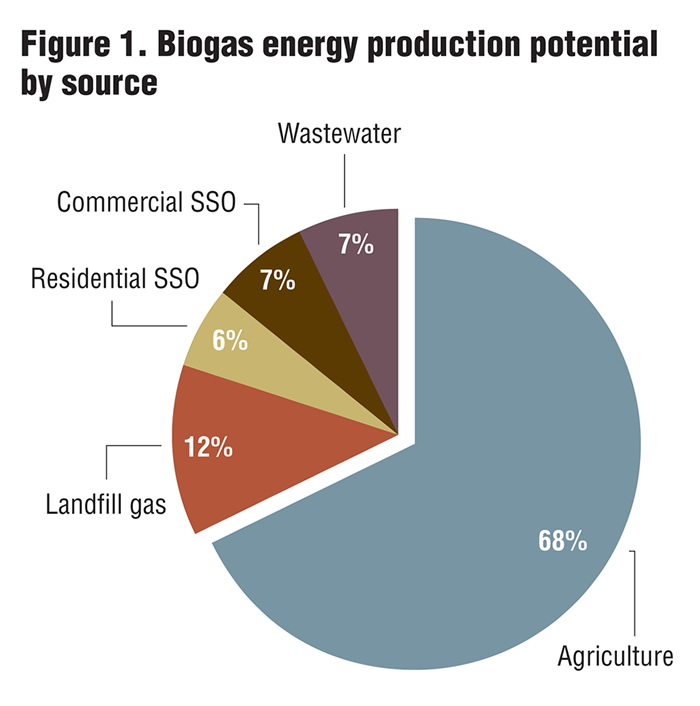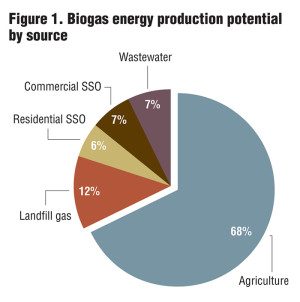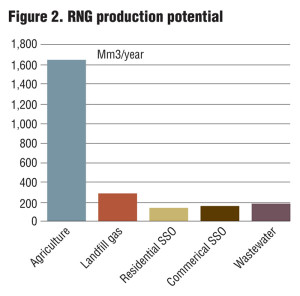New study reports that about two-thirds of the potential national biogas contribution would come from on-farm anaerobic digesters.
Peter Gorrie
BioCycle December 2013
Biogas could meet three percent of Canada’s natural gas needs or 1.3 percent of its electricity demand, says a new report compiled for the Biogas Association, the national biogas and anaerobic digestion industry advocacy group. The $65,000 study was funded by the federal and Ontario governments; Hydro One, which runs Ontario’s transmission grid; and three industry members: Harvest Power, Anaergia Inc., and European Power Systems.
“While biogas energy is in the relatively early stages of development in Canada, the opportunities for growth are significant, and would contribute to sustainability in communities across the country,” states the summary report of the “Canadian Biogas Study,” prepared by two consulting companies based in Toronto, Ontario — Kelleher Environmental and Robins Environmental. The report divides biogas generators into five sectors: Agricultural digesters, landfill gas (LFG), anaerobic digestion of residential Green Bin waste, anaerobic digestion of commercial organic/biodegradable waste, and wastewater treatment plants. Of those five sectors (Figure 1), agricultural digesters have the potential to produce the most biogas (68%), followed by LFG (12%), wastewater (7%), commercial organics (7%), and residential organics (6%).
The Association’s study notes that about two-thirds of the potential national biogas contribution — enough to fuel electricity generators with a capacity of up to 810 megawatts or to refine into 2,420 million cubic meters of renewable natural gas (RNG), or biomethane — would come from on-farm anaerobic digesters (Figure 2). Nearly 12 percent would be accounted for by landfill gas, with the remainder equally divided among source separated residential and commercial organic waste digesters and wastewater treatment plants.
The full potential of biogas could cut Canada’s annual greenhouse gas emissions by the equivalent of 37.5 million metric tons of carbon dioxide, equivalent to taking 7.5 million cars off the road, says the report. Biogas would also generate economic benefits, notes the study. Construction of up to 1,800 biogas facilities would require capital investment of $7 billion, with an economic spinoff of $21 billion. Construction projects would create about 16,700 jobs for one year, and about 2,650 long-term jobs operating the facilities. Details of the calculations were to be presented in a forthcoming technical document.
The study “helps us provide a range of specific benefits and messages to help build the case for widespread use of biogas,” says Biogas Association president Jennifer Green. “A lack of reliable, quantified information on the full range of biogas impacts (is) a key barrier to the development of policies and partnerships that would accelerate the growth of the biogas sector.” The Canadian government and most provincial administrations have, as yet, no policies to promote biogas. The study will buttress the case for them, Green adds.
At the national level, the policies proposed in the study focus on renewable natural gas. They include support for innovation “to improve production and efficiencies for our climate and conditions;” municipal procurement standards for RNG use in vehicles; development of a mandatory RNG blend for all natural gas distributors; and tax exemptions for RNG use.
Ontario’s Long-Term Energy Plan
A few days after the report’s release, the Ontario government unveiled its 2013 Long-Term Energy Plan, which, the Biogas Association says, should help biogas achieve its potential, at least in Canada’s most populace province. For Ontario, the proposed policies aim to promote electricity generation from biogas. The province already includes biogas projects in its Feed-in Tariff, or FIT, program, which pays a premium for electricity supplied to the grid from renewable sources.
The Association wants a 10 percent set-aside for biogas in future FIT procurements in Ontario, additional payments for electricity generated when crop residuals are part of the digester feedstock, and other policies to boost the supply of crop residuals and support increased diversion of organic wastes from landfills. While the new long-term energy plan, intended to ensure an adequate energy supply for Ontario until 2032, doesn’t meet these demands, it is still good news, Green says.
Biogas producers should benefit from measures to promote bioenergy, which comprises energy, “produced from living or recently living plants or animal sources,” including food- and forest-industry wastes, manure, crop residues, biosolids and source separated residential organics. Ontario’s installed bioenergy generating capacity now totals 300 megawatts, including 55 megawatts from biogas (the remainder is from biomass and landfill gas recovery).
Because of controversy over siting of wind turbines and solar farms, and concern over rising costs for renewable energy, the Ontario FIT program now applies only to projects with an installed capacity of less than 500 kilowatts. The 2013 Plan promises a new competitive procurement process for projects larger than 500 kilowatts. As part of that process, it commits to purchase 50 megawatts worth of bioenergy generating capacity in each of the next two years. It is the first time bioenergy has had its own target apart from wind, solar and the rest. Aside from stipulating that the new process will “take into account local needs and considerations,” the Plan offers no other details. “It is helpful to have a dedicated bioenergy target,” Green says. In the province’s previous energy plan, “we were grouped together as nonhydro renewables.”
In addition, the Ministry of Energy and the Ontario Power Authority, which manages the province’s electricity generating system, will develop specific procurements tied to the use of combined heat and power from agrifood and greenhouse operations. The Plan also promises increased access to oil and natural gas for rural communities, particularly through natural gas pipelines and distribution networks, which should help to promote production of RNG from biogas projects.
Peter Gorrie is a Contributing Editor to BioCycle.















